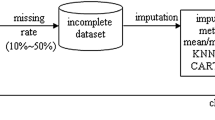Abstract
Most of the classification algorithms (e.g. support vector machines, neural networks) cannot directly handle Missing Values (MV). A common practice is to rely on data pre-processing techniques by using imputation or simply by removing instances and/or features containing MV. This seems inadequate for various reasons: the resulting models do not preserve the uncertainty, these techniques might inject inaccurate values into the learning process, the resulting models are unable to deal with faulty sensors and data in real-world problems is often incomplete. In this paper we look at the Missing Values Problem (MVP) by extending our recently proposed Neural Selective Input Model (NSIM) first, to a novel multi-core architecture implementation and, second, by validating our method in a real-world financial application. The NSIM encompasses different transparent and bound (conceptual) models, according to the multiple combinations of missing attributes. The proposed NSIM is applied to bankruptcy prediction of (healthy and distressed) French companies, yielding much better performance than previous approaches using pre-processing techniques. Moreover, the Graphics Processing Unit (GPU) implementation reduces drastically the time spent in the learning phase, making the NSIM an excellent choice for dealing with the MVP.
Access this chapter
Tax calculation will be finalised at checkout
Purchases are for personal use only
Preview
Unable to display preview. Download preview PDF.
Similar content being viewed by others
References
Aikl, L., Zainuddin, Z.: A comparative study of missing value estimation methods: Which method performs better? In: Proc. International Conference on Electronic Design (ICED 2008), pp. 1–5 (2008)
Ayuyev, V.V., Jupin, J., Harris, P.W., Obradovic, Z.: Dynamic clustering-based estimation of missing values in mixed type data. In: DaWaK 2009: Proceedings of the 11th International Conference on Data Warehousing and Knowledge Discovery, pp. 366–377. Springer, Heidelberg (2009)
Friedman, M., Kandel, A.: Introduction to Pattern Recognition: Statistical, Structural, Neural, and Fuzzy Logic Approaches. World Scientific, Singapore (1999)
García-Laencina, P., Sancho-Gómez, J.L., Figueiras-Vidal, A.: Pattern classification with missing data: a review. Neural Computing & Applications 19, 263–282 (2010)
Kotsiantis, S.B., Zaharakis, I.D., Pintelas, P.E.: Machine learning: a review of classification and combining techniques. Artif. Intell. Rev. 26(3), 159–190 (2006)
Lopes, N., Ribeiro, B.: Hybrid learning in a multi-neural network architecture. In: Proceedings of the International Joint Conference on Neural Networks (IJCNN 2001), vol. 4, pp. 2788–2793 (2001)
Lopes, N., Ribeiro, B.: GPU implementation of the multiple back-propagation algorithm. In: Corchado, E., Yin, H. (eds.) IDEAL 2009. LNCS, vol. 5788, pp. 449–456. Springer, Heidelberg (2009)
Lopes, N., Ribeiro, B.: A strategy for dealing with missing values by using selective activation neurons in a multi-topology framework. In: IEEE World Congress on Computational Intelligence, WCCI (2010)
López-Molina, T., Pérez-Méndez, A., Rivas-Echeverría, F.: Missing values imputation techniques for neural networks patterns. In: ICS 2008: Proceedings of the 12th WSEAS International Conference on Systems, pp. 290–295. World Scientific and Engineering Academy and Society, WSEAS (2008)
Ribeiro, B., Lopes, N., Silva, C.: High-performance bankruptcy prediction model using graphics processing units. In: IEEE World Congress on Computational Intelligence, WCCI (2010)
Ripley, B.D.: Pattern Recognition and Neural Networks. Cambridge University Press, New York (2008)
Tang, H., Tan, K.C., Yi, Z.: Neural Networks: Computational Models and Applications (Studies in Computational Intelligence). Springer-Verlag New York, Inc., Secaucus (2007)
Tuikkala, J., Elo, L., Nevalainen, O., Aittokallio, T.: Missing value imputation improves clustering and interpretation of gene expression microarray data. BMC Bioinformatics 9(1), 202 (2008)
Vieira, A.S., Duarte, J., Ribeiro, B., Neves, J.C.: Accurate prediction of financial distress of companies with machine learning algorithms. In: Kolehmainen, M., Toivanen, P., Beliczynski, B. (eds.) ICANNGA 2009. LNCS, vol. 5495, pp. 569–576. Springer, Heidelberg (2009)
Author information
Authors and Affiliations
Editor information
Editors and Affiliations
Rights and permissions
Copyright information
© 2011 Springer-Verlag Berlin Heidelberg
About this paper
Cite this paper
Lopes, N., Ribeiro, B. (2011). A Robust Learning Model for Dealing with Missing Values in Many-Core Architectures. In: Dobnikar, A., Lotrič, U., Šter, B. (eds) Adaptive and Natural Computing Algorithms. ICANNGA 2011. Lecture Notes in Computer Science, vol 6594. Springer, Berlin, Heidelberg. https://doi.org/10.1007/978-3-642-20267-4_12
Download citation
DOI: https://doi.org/10.1007/978-3-642-20267-4_12
Publisher Name: Springer, Berlin, Heidelberg
Print ISBN: 978-3-642-20266-7
Online ISBN: 978-3-642-20267-4
eBook Packages: Computer ScienceComputer Science (R0)




